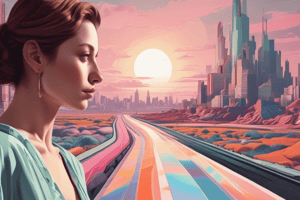Podcast
Questions and Answers
Which of the following statements is true about art and politics?
Which of the following statements is true about art and politics?
- Art is a passive medium for personal expression
- Art has been used to promote progressive social change
- Art has been used to consolidate the status quo
- Art has been used to challenge the status quo (correct)
What is the purpose of political art?
What is the purpose of political art?
- To extend the control of those in power
- To evoke a critical stance on the socio-economic and political system (correct)
- To revolutionise society
- To promote art for art's sake
What enabled artists to become more vocal and critical?
What enabled artists to become more vocal and critical?
- The great depression
- The modern era (correct)
- Postmodernism
- The attack on Charlie Hebdo
What is shock art?
What is shock art?
What is the purpose of art as propaganda?
What is the purpose of art as propaganda?
What sparked a debate about the need to balance freedom of expression in the arts whilst protecting religion?
What sparked a debate about the need to balance freedom of expression in the arts whilst protecting religion?
What has been a source of patronage for artists for centuries?
What has been a source of patronage for artists for centuries?
What is the current state of the art?
What is the current state of the art?
What is the purpose of satire in religious art?
What is the purpose of satire in religious art?
What is the stance of France and Denmark on freedom of expression in the arts?
What is the stance of France and Denmark on freedom of expression in the arts?
Flashcards are hidden until you start studying
Study Notes
- Art and politics are strongly intertwined, as art is a vocal medium for personal expression and can showcase a particular stance or ideology.
- Creativity implies novelty which in turn promotes change.
- Art has been used by artist in the past and present to promote progressive social change and contrastingly, by those in power so as to consolidate their status quo (their existing state of affairs).
- Some art works go beyond "art for art's sake" as it can address direct issues of status and power, inequality, justice, and corruption.
- Political art refers to works which aim to evoke a critical stance on the socio-economic and political system by challenging the status quo.
- Artists have used their art to critique and undermine these systems often at a great personal risk for going against society.
- Not all political art calls for resistance or change as one can note through art as propaganda, which is a means to extend the control of those in power.
- Society has been revolutionised by various artist, from Picasso and Duchamp to Banksy and Weiwei.
- Before the modern era of art, artworks largely propagated the status and agenda of those in power such as the church and ruling class elite.
- Artists were very limited to express their personal views through their art as it was solely there to serve a function.
- The modern era enabled artists to become more vocal and critical.
- The great depression after the 1" world war, offered a breeding ground for political art as artists were moving away from the ties of great art establishments.
- In the 1960s and 1970s, artists took on an activist role in supporting various groups with their struggles such as civil rights movement, LGBTIQ+ rights, labour rights, women's rights, and environmentalism.
- The current state of the art is that artists are using new mediums such as AI and VR to create immersive experiences which can be used to communicate social issues.
- Postmodernism has led to political art becoming more complex and difficult to understand.
- Shock art is a type of political art that often uses shock value to provoke reactions.
- Religious art has been a source of patronage for artists for centuries, but in the early 20th century, modernism led to a shift where artists explored new subjects.
- Since the post-modern era, religious art has been seen as alien to contemporary art, but certain artists have continued to explore religious content in satirical and provocative ways.
- Some artists have been met with backlash for their satirical depictions of religious figures, but others have been praised for their work.
- The attack on Charlie Hebdo sparked a debate about the need to balance freedom of expression in the arts whilst protecting religion.
- Some countries, such as France and Denmark, have declared their stance on this issue and stated that they are in favour of holding on to their values.
- Freedom of expression cannot stop anyone from criticising provocative artworks, as after all, the aim of shock art is to spark controversy and provocation which itself leads to criticism.
- The fact remains that no one was killed for such cartoons, and no one can dispute the fact that artists like Ofili, Charlie Hebdo and Merino were simply exercising their right to express views which remains fundamental in today's society.
- Courts cannot prevent the freedom of expression just because it shocks or insults people.
Studying That Suits You
Use AI to generate personalized quizzes and flashcards to suit your learning preferences.




